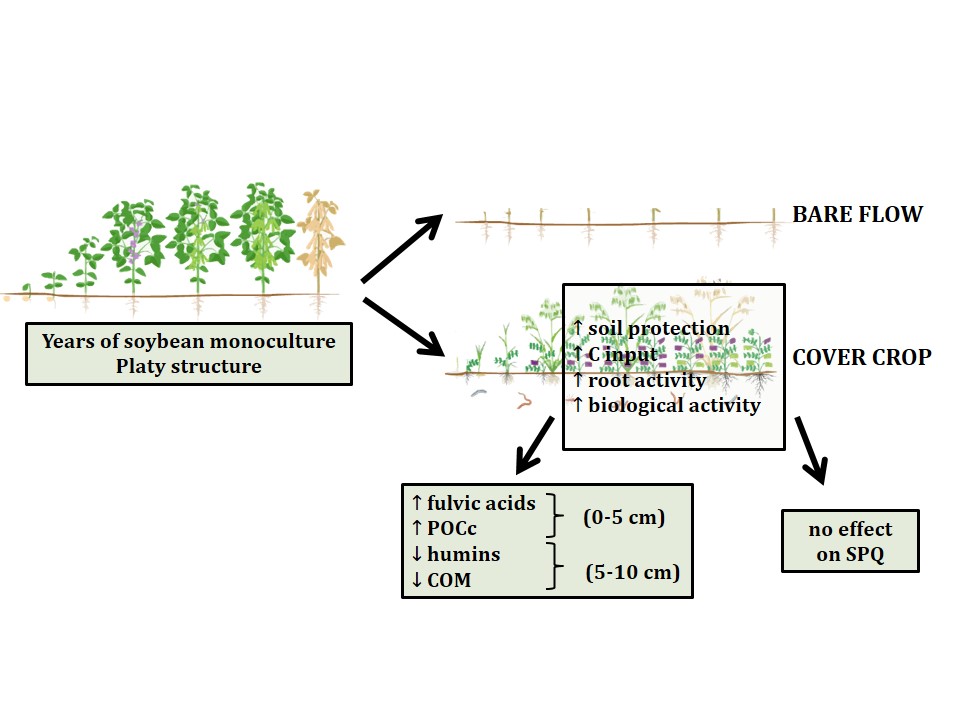Winter cover crops effects on soil organic carbon and soil physical quality in a Typical Argiudoll under continuous soybean cropping
27/Nov/2020
ABSTRACT The massive adoption of no-tillage (NT), along with the simplification of the cropping sequences has led to physical and chemical degradation of soils. To recover degraded soils, cover crops have been proposed as an alternative to increase soil organic carbon (SOC) and to improve soil physical quality (SPQ). This study aimed (i) to determine the content of SOC and its physical and chemical fractions at different layers and positions, in a soil with a soybean crop under NT with […]
Solubility of Heavy Metals/Metalloid on Multi-Metal Contaminated Soil Samples from a Gold Ore Processing Area: Effects of Humic Substances
17/Jun/2016
ABSTRACT Bioavailability of heavy metals at contaminated sites is largely controlled by the physicochemical properties of the environmental media such as dissolved organic matter, hydroxides and clay colloids, pH, soil cation exchange capacity and oxidation-reduction potential. The aim of this study was to investigate soil pH and heavy metal solubility effect by levels of humic and fulvic acids applied in soil samples with different levels of contamination by heavy metals. The soil samples used in this study were collected in […]
Quality of soil organic matter under coffee intercropped with green manure
01/Dec/2013
The input of organic residues associated with the humification process promotes improvement of soil properties and enables the sustainability of the production system. Aside from supplying the coffee with nutrients, pulse crops can improve the quality of soil organic matter by forming humic substances. The purpose of this study was to evaluate the effect of green manures legumes on the quality of humic substances in soils under coffee under two environmental conditions in the region of Zona da Mata, in […]
Partitioning of humic substances in brazilian soils
01/Aug/2013
Humic substances (HS) are the main pool of total soil organic carbon (TOC). They are partitioned in different fractions according to its solubility in alkali or acid medium, which can be related to soil type and management. This work aimed to compare HS partitioning in Brazilian soils according to soil depth, soil type, biome, and land uses. In a literature review of theses, dissertations, journal articles, and abstracts in proceedings, quantitative data on TOC partitioning in humic acids (HA), fulvic […]
Lignocellulosic and isotopic composition of vegetation and soil organic matter of a tropical peat. II humic substances and humification processes
01/Feb/2013
Much of the organic matter of a typical peat consists of humic substances, mainly formed via humification of organic residues, decomposed by soil microorganisms, and by the polymerization of organic compounds to functional macromolecules, which are normally more resistant to degradation. The fundamental pathways governing the humification of soil organic matter (SOM) are not well understood so far, and most available data about the identified chemical precursors of humic substances and the main chemical routes by which they are transformed […]
Contribution of humic substances from different composts to the synthesis of humin in a tropical soil
01/Aug/2010
The contribution of humic substances of different composts to the synthesis of humin in a tropical soil was evaluated. Increasing doses (0, 13, 26, 52, and 104 Mg ha-1) of five different composts consisting of agroinpowderrial residues were applied to a Red-Yellow Latosol. These composts were chemically characterized and 13C NMR determined and the quantity of the functional alkyl groups of humic acids applied to the soil as compost was estimated. Thirty days after application of the treatments, organic matter samples were […]
Peat bogs in the Serra do Espinhaço Meridional – Minas Gerais, Brazil. II – influence of drainage on elemental humus composition and substances
01/Oct/2009
Peat bogs are Organosols formed under ideal ecological conditions in terms of the accumulation of organic material, controlled by geomorphological and geological processes and climate. The physical, chemistry and biological constitution of peat bogs is largely unknown. In this study the peat bogs of the Southern Serra do Espinhaço (Minas Gerais, Brazil) were described and sampled from three profiles at 1,250 m (P1), 1,350 m (P4) and 1,800 m (P2) above sea level. The three profiles were characterized morphologically, the […]
Distribution and characterization of humic substances in animal and plant vermicompost
01/Dec/2008
The use of organic residues as fertilizers and soil conditioners requires their maturation and the quality monitoring of the final product. Vermicomposting is a technique which, along with the composting process, eliminates the potential harmful effect of manure residues to human health and soil. The stability and maturity degrees of a given vermicompost are usually inferred from the quantity and quality of the humic substances in the resulting compost. This study aimed to evaluate the quality and maturity of vermicomposts […]
Organic carbon stock and quantification of humic substances of an oxisol under continuous sewage sludge application
01/Aug/2007
This study was carried out to evaluate the effect of continuous sewage sludge applications (Sewage Treatment Station of Barueri, São Paulo State, Brazil) on the C content and stock and on the distribution of C-humic fractions of a Red Latosol (Oxisol). The experiment was installed in 1999 on an experimental field of Embrapa Environment, in Juaguariúna (SP). The data were collected after the sixth sludge application (SS) with corn cultivation. The following accumulated SS doses (dry base) were tested: 0, […]
Stocks and quality of organic matter in an inceptisol under long-term sugarcane cultivation
01/Apr/2007
The aim of this study was to evaluate the stocks, and quality of the soil organic matter (SOM) through the use of solid state 13C nuclear magnetic resonance (13C NMR), electronic paramagnetic resonance (EPR) and fluorescence spectroscopy of a fine clay fluventic Eutrichrept after long-term sugarcane cultivation. In one area, sugarcane has been grown for 55 years no field burning before harvest. In another area managed under the traditional system the crop field has been burned before harvest for 35 […]

